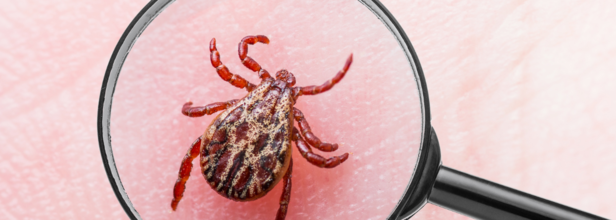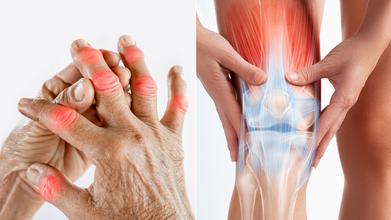- Health Conditions A-Z
- Health & Wellness
- Nutrition
- Fitness
- Health News
- Ayurveda
- Videos
- Medicine A-Z
- Parenting
- Web Stories
Family Shares How A Lyme Disease Misdiagnosis Cost Their Son's Childhood

Credits: Canva
An 8-year-old Myrtle Beach boy has Lyme disease and his parents are doing everything they can to treat him, so he could have a "normal childhood", reports News13.
As per the National Library of Medicine, USA, Lyme disease, also known as Lyme borreliosis, is an infectious condition, which is transmitted through the bite of infected ticks. This is primarily caused by the spirochete bacterium Borrelia burgdorferi in the United States and various Borrelia species in Europe and Asia.
How Was The Child Diagnosed With Lyme Disease?
The parents, LeeAnn and Brian Kuhl, said that their son, Ben, one day came home with a tick bite on his belly button after a hike he went on four years go. He was four at that time.
The doctors had told the Kuhls that since Ben's tick bite did not have a bullseye on it, there was nothing to be concerned about. Therefore, Lyme disease was not even something in their mind. However, things changed soon, and Ben was diagnosed.
By the time he was diagnosed, the disease had spread to all Ben's organs, including his brain. He was only able to talk on some days, his motor functions also worsened. He now has a very painful inflammation, and spends most of his time indoors.
“You mourn the life that he was supposed to have, so you mourn the parent that you were supposed to be,” LeeAnn said.
The parents also share that his symptoms have affected his friendships with other children. “I see the frustration when he can’t play with them because they’re at a faster pace now than he is,” LeeAnn said. “It’s sad because, when they’re all goofing around, he wants to be in there, too, but he can’t talk to them.”
The Progression Of Lyme Disease
The National Library of Medicine notes that this disease typically develops in three stages: early localized, early disseminated, and late stage. Early signs often include a telltale “bull’s-eye” rash (erythema migrans), along with fever and fatigue.
Without treatment, the infection can spread, affecting the nervous system, heart, and joints. In its late stage, it may cause chronic arthritis and brain-related issues, highlighting the critical need for early detection and timely treatment.
However, the treatment is not cheap. The Kuhls told News13 that they spend hundreds of dollars per month and that not all his medicines are covered by insurance. In fact, Brian has started working two jobs, and is sill looking for more work.
The Kuhls told News13 that they have found a community in Myrtle Beach who are helping them with Ben's treatment.
“We had all these people coming to us and offering to pay for a month of supplements or offering services to him,” LeeAnn said. “Without them, we could not be where we are right now.”
While Ben will always be affected by this disease, there is a hope that he will eventually be in full remission. Till then, they are not giving up on their hopes to see their child healthy.
“He is going to be such a testimony on not giving up,” LeeAnn said. “We tell him every day, ‘you’re going to stand there one day, and you’re going to speak to a bunch of people who are going through something, and you’re going to tell them what God did for you.’”
Early Signs Of Lyme Disease
The early signs shows somewhere between 3 to 30 days after tick bite, notes the Centers for Disease Control and Prevention, USA (CDC).
The signs and symptoms include:
Fever, chills, headache, fatigue, muscle and joint aches, and swollen lymph nodes may occur in the absence of rash
Erythema migrans (EM) rash:
- Occurs in approximately 70 to 80 percent of infected people
- Begins at the site of a tick bite after a delay of 3 to 30 days (average is about 7 days)
- Expands gradually over several days reaching up to 12 inches (30 cm) or more across
- May feel warm to the touch but is rarely itchy or painful
- Sometimes clears as it enlarges, resulting in a target or "bull's-eye" appearance
- May appear on any area of the body
- Does not always appear as a "classic bull's-eye" rash
Later signs, which may come after a month of being bitten, notes CDC are:
- Severe headaches and neck stiffness
- Additional EM rashes on other areas of the body
- Facial palsy (loss of muscle tone or droop on one or both sides of the face)
- Arthritis with severe joint pain and swelling, particularly the knees and other large joints.
- Intermittent pain in tendons, muscles, joints, and bones
- Heart palpitations or an irregular heartbeat (Lyme carditis)
- Episodes of dizziness or shortness of breath
- Inflammation of the brain and spinal cord
- Nerve pain
- Shooting pains, numbness, or tingling in the hands or feet
New Developments Like Lower Doses of Radiation And Drug-filled Cartilage Could Help In Arthritis Treatment

Credits: Canva
Each year on October 12 the world observes Arthritis Day to bring attention to the medication condition and ways to find out to prevent and to treat it as there is no cure. However, apart from the traditional treatments like medication, physical therapy, lifestyle changes, and surgery to manage symptoms, there have ben new treatments in the recent times too. Before jumping into what those treatments are, let us first understand what is arthritis?
It is a medical term for joint pain, inflammation, and stiffness, with over 100 different types. It also includes osteoarthritis and rheumatoid arthritis.
Osteoarthritis: It is a progressive, degenerative joint disease where the protective cartilage cushioning the ends of the bones breaks down. It then causes pain, stiffness, swelling and reduced mobility and affects the hands, knees, hips and spine.
Rheumatoid Arthritis: It is a chronic autoimmune disease that causes pain, swelling, stiffness, and warmth in the joints and affects mostly small joints of hands and feet in a symmetrical pattern. It occurs when the immune system attacks the body's own tissue, particularly the lining of the joints and leads to inflammation or even damage to cartilage and bones.
What Are The New Treatment On Arthritis?
As per the multiple new studies present at the American Society of Radiation Oncology (ASTRO), 2025, researchers from Korea, the US, and Germany reported that mild doses of radiation can significantly reduce pain and also improve mobility in patients with osteoarthritis.
Radiation Therapy For Arthritis
In South Korea, a randomized clinical trial was conducted with 114 volunteers, who had knee arthritis, and were treated with 3 Gy of radiation, which had spread over six sessions. Researchers also noticed that 70% of participants experienced meaningful improvement in pain, function and overall functioning. This was way higher than the 42% improvement seen in the placebo group.
Low-dose radiation is already common in the Europe. However, strong randomized data was limited till now. Dr Byong Hyuck Kim of the Seoul National University, who led the study also emphasized that here, the radiation doses are 10 to 20 times lower than cancer therapy levels and targets only the joints far from the vital organs.
Artificial Cartilage Helps Arthritis
Researchers from the University of Cambridge designed an artificial cartilage that could help with arthritis treatment. This 'cartilage' can sense tiny changes in the body, including arthritis flare-up and release drugs exactly when and where they are needed.
The 'cartilage' is squishy in nature and can be loaded with anti-inflammatory drugs that are released in response to small changes in pH in the body. During arthritis flare-up, joint becomes inflamed and more acidic. The 'cartilage' becomes softer as the change in pH is noticed, especially when the acidity increases and it triggers the release of drug molecules that can be encapsulated within its structure.
The entire study is published in the Journal of American Chemical Society.
World Arthritis Day 2025: Date, Theme, Significance And History Explained

Credits: Canva
Every year, people across the world unite on World Arthritis Day to spread awareness about arthritis and related disorders. Observed annually on October 12, the day aims to draw attention to the everyday challenges faced by those living with arthritis, encourage early diagnosis, and promote better medical care and support systems.
As World Arthritis Day 2025 approaches, it’s a timely reminder to learn about its theme, importance, and the role each of us can play in improving the lives of those affected.
Why World Arthritis Day Matters
Arthritis is often mistaken for a simple case of joint pain, but it is far more complex. It includes a wide range of conditions that can impact a person’s mobility, independence, and overall well-being. One of the main goals of World Arthritis Day is to break these misconceptions, spread accurate information, and raise awareness that arthritis can affect anyone, regardless of age.
Raising awareness also encourages timely medical consultation, physiotherapy, and healthier lifestyle choices that can help manage symptoms and prevent complications.
World Arthritis Day 2025 Theme
The theme for World Arthritis Day 2025 is “Realizing Your Dreams” or “The Courage to Dream.” This year’s message highlights the importance of personal aspirations and resilience among people living with rheumatic and musculoskeletal diseases (RMDs). It inspires individuals to pursue their dreams while encouraging collaboration between patients, doctors, and advocates to turn those dreams into reality.
The theme serves as a reminder that arthritis is not just a physical condition, it is about preserving one’s independence, dignity, and quality of life.
When Is World Arthritis Day Celebrated?
World Arthritis Day is marked every year on October 12 around the globe. In India too, this day is recognised and observed to underline the importance of awareness and education about arthritis. With lifestyle changes and rising stress levels, arthritis is now being diagnosed in younger people as well, making awareness even more vital.
Ways to Raise Awareness on World Arthritis Day 2025
Spreading awareness is not limited to medical professionals or organizations. Every individual can help in small but meaningful ways. Some simple ideas include:
- Educational Programs: Schools, offices, and community groups can organize sessions to teach people about arthritis symptoms and preventive care.
- Social Media Campaigns: Sharing real-life stories, verified facts, and official theme posters can reach thousands online.
- Community Events: Walkathons or charity runs can raise both funds and awareness.
- Free Health Camps: Clinics and hospitals can offer free joint check-ups to encourage early diagnosis.
These collective efforts ensure that arthritis is not ignored or misunderstood, but openly discussed and addressed.
Tips for Living with Arthritis
Awareness is the first step, but supporting those who live with arthritis every day is just as important. Here are some ways to help manage the condition and maintain a good quality of life:
Stay Active, but with Care
Choose gentle exercises such as walking, yoga, or swimming to keep joints flexible and reduce stiffness without straining them.
Eat a Balanced Diet
Include anti-inflammatory foods such as leafy greens, fatty fish rich in omega-3, nuts, and olive oil to help ease inflammation.
Get Enough Rest
Quality sleep helps the body recover. Avoid overexertion but stay active enough to prevent stiffness.
Use Supportive Tools if Needed
Walking sticks, braces, or other assistive devices can reduce stress on joints and make movement easier.
Maintain a Positive Outlook
Joining arthritis support groups or connecting with others who share similar experiences can provide motivation and emotional support.
For those seeking specialized treatment, visiting a reputed multispeciality hospital in Coimbatore can help patients receive comprehensive arthritis care, from diagnosis to therapy and rehabilitation, under one roof.
Is Donald Trump Showing Early Phonemic Paraphasia? Here’s Why Health Experts Think So

As Donald Trump recently went for his second health checkup, the visit, announced earlier this week by the White House comes as he prepares to travel to the Middle East following a ceasefire deal in the Israel-Hamas war. White House press secretary Karoline Leavitt called it a “routine yearly checkup,” even though the president had already undergone his annual physical in April. According to a memo obtained by CBS News on Friday evening, written by Trump’s physician, Capt. Sean Barbabella, the president “successfully completed a scheduled follow-up evaluation.”
The president also received his annual flu vaccination and an updated COVID-19 booster. Interestingly, his cardiac age, a validated measure of cardiovascular health via ECG was found to be roughly 14 years younger than his chronological age. However, health experts remain concerned, with many noting potential signs of dementia. Now, some specialists are also pointing to early indicators of phonemic paraphasia in his speech.
What Is Phonemic Paraphasia That Health Experts Believe Donald Trump Has Signs Of?
Phonemic paraphasia is a type of speech error where sounds within a word are substituted, added, or rearranged, creating a nonword that still sounds similar to the intended word (for example, “tephelone” instead of “telephone”). It is commonly seen in language disorders such as Wernicke’s aphasia and conduction aphasia, caused by difficulty selecting the correct phonemic segments. People with this condition usually understand what they want to say but struggle with producing the correct sounds.
What Are Psychologists Saying About Donald Trump’s Health?
Even during Trump’s first term, his cognitive and psychological traits attracted attention. Observers noted he struggled to focus on a single topic, and his public remarks raised concern among psychiatrists. In 2017, 27 mental health professionals collectively published The Dangerous Case of Donald Trump, warning that his mental state, combined with presidential powers, could pose risks to global security.
Dr. Bandy Lee, who taught for 17 years at Yale School of Medicine, first noticed potential neurocognitive issues in Trump in 2017 and says his condition has steadily declined since then. The manifesto, published on Nov. 3, 2024, titled Statement on Cognitive Decline in the Presidential Election, lists symptoms including simpler vocabulary, incomplete sentences, grammatical mistakes, paraphasias, vague or inappropriate statements, compulsive repetition of thoughts (“perseveration”), increased use of profanity, and pronounced narcissistic traits.
Some of Trump’s invented words even went viral during his first term. The infamous “covfefe” tweet is one example, where he likely meant “coverage” but created a nonsensical word that became a meme and appeared on protest signs and in advertisements.
Health Experts Believe Donald Trump Also Has Dementia
Harry Segal, a senior psychology lecturer at Cornell University, has observed early signs of dementia in Trump. “What’s alarming is how the rate of Trump’s unusual speech and political decisions has been increasing. He once gave an incoherent answer about childcare to the Economic Club of New York… Trump has shown evidence of dementia over the past year, indicated by his strange gait, phonemic paraphasia, and a decline in word complexity,” Segal said. He believes these factors explain Trump’s refusal to debate Kamala Harris a second time and his increasingly impulsive speeches.
What Are the Symptoms of Phonemic Paraphasia?
The main symptom is substituting a word with a nonword that sounds similar, such as saying “wishdasher” instead of “dishwasher.” Other signs include:
- Errors where sounds in a word are replaced with different sounds
- Producing non-real words that resemble the intended word
- Difficulty finding words and substituting unrelated terms (semantic paraphasia)
- Repeated attempts to correct themselves, sometimes abandoning the word entirely
- Lack of awareness of these mistakes
Who Is Affected by Phonemic Paraphasia?
- Individuals with aphasia: Particularly Wernicke’s and conduction aphasia
- People with brain lesions: Often in the posterior temporal lobe or internal/external capsules, areas involved in language
- Individuals with other neurological conditions: Early dementia is frequently associated with phonemic paraphasia
© 2024 Bennett, Coleman & Company Limited

